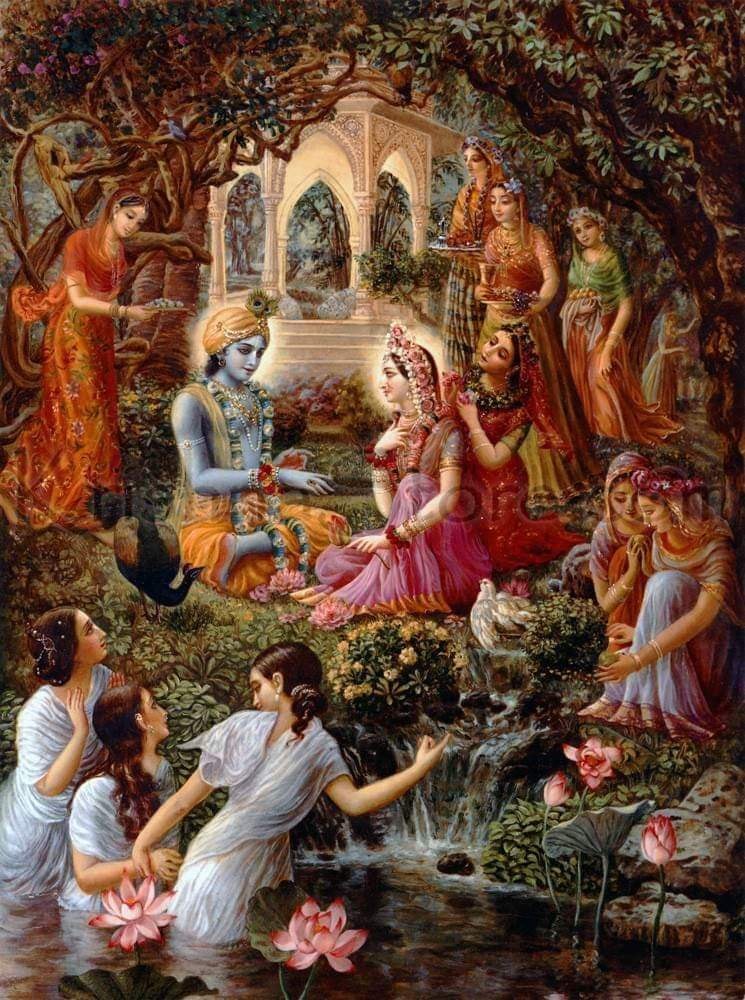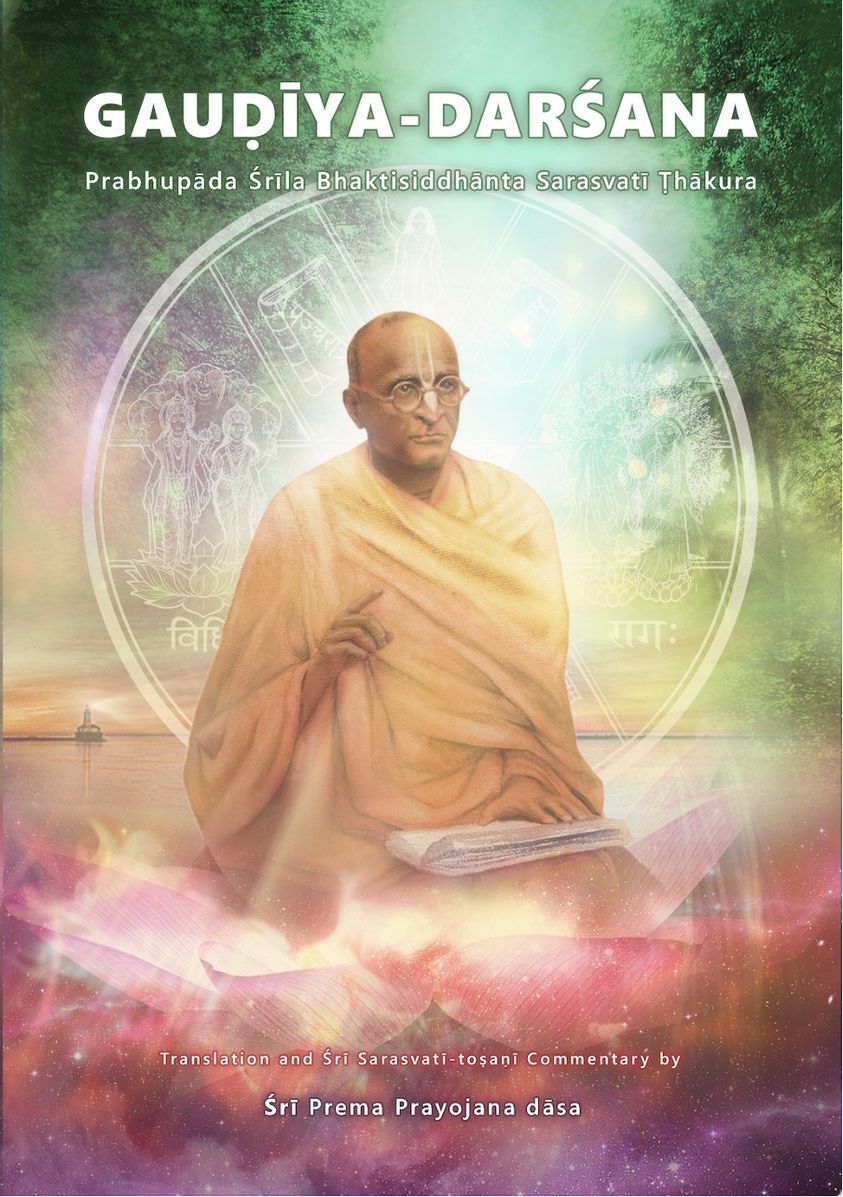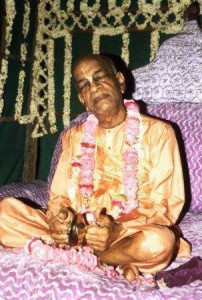 Srila Bhaktivedanta Swami Prabhupada |
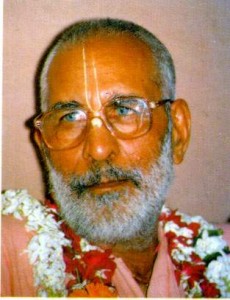 Srila Bhaktivedanta Narayana Maharaja |
My Public Apology
By Syamarani dasi
My respectful dandavats to all Vaisnava Readers,
All glories to Sri Guru and Gauranga.
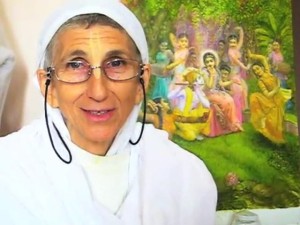
Srimati Syamarani Dasi
I desire to make a public apology. This apology is for something I had forgotten I did, but yesterday was reminded that I did in back in 1970. Thinking that I was properly glorifying Srila Prabhupada but basing my statements on sheer misinterpretation, I did something really dumb. I was young. I didn’t realize that I was as good as saying that Srila Prabhupada was not in the bhagavat-parampara delineated by his Guru Maharaja, Srila Bhaktisiddhanta Sarasvati Thakura.
I wrote in 1970, and I was also preaching throughout the 1970s, that my divine Guru Maharaja, Srila Prabhupada Bhaktivedanta Svami Maharaja, is a cowherd boy in his siddha-deha, his form as an associate of Sri Krsna in Goloka Vrndavana.
I used to believe that to be true – in other words I used to derail myself and hundreds or thousands of my ISKCON brothers and sisters – until I met my siksa-guru Srila Bhaktivedanta Narayana Gosvami Maharaja, who gave Prabhupada’s mercy to me and thousands of other fortunate souls. He taught us Prabhupada’s true glory as a great Rupanuga acarya, a follower and preacher of the true mission of Sri Caitanya Mahaprabhu as established by Srila Rupa Gosvami, and a gopi maidservant of Srimati Radhika under the leadership of Sri Rupa Manjari.
I am very repentant for my blunder, and at the same time I am very sorry that the book “O My Friend,” the aim of which is to propagate the same misunderstanding, quoted my silly blunder statements as part of their ‘evidence’ to prove their theory.
In the early 2000s, under the guidance of Srila Bhaktivedanta Narayana Gosvami Maharaja and with the help of senior Vaisnavas, I wrote an article refuting some misinformed internet statements on this topic. Then today, after hearing and seeing that my name (the name “Jadurani dasi”) and my misleading statements were quoted in “O My Friend,” I felt so sad. I therefore did some editing of that article with reference to the statements in “O My Friend,” and in my repentance I would like to share that article with you.
Your aspiring servant,
Syamarani dasi
Srila Prabhupada Is In The Highest Rasa
By Syamarani dasi
This presentation is a response to the book, “O My Friend.” Therein the authors shared their idea that the relationship of our Srila Prabhupada, Sri Srimad Bhaktivedanta Svami Maharaja, with Sri Krsna is one of sakhya-rasa, as a priya-narma sakha, an intimate cowherd-boy friend of Krsna. The evidence quoted in this response shows that Srila Prabhupada, following in the footsteps of our previous rupanuga acaryas, is not at all a cowherd-boy. He is actually in madhurya-rasa. He has instructed us by his own activities in a very specific way, one which is entirely consonant with the precepts of madhurya-rasa given in the line of Srila Rupa Gosvami. A careful study of his writings and recorded instructions, as well as the writings of other acaryas, makes this very clear.
Although the subject matter of this article is normally not discussed in a public forum, we were requested to do so by senior devotees, so that Srila Prabhupada’s position would not be misunderstood and Srila Prabhupada’s glory and mission would not be undermined. If his position is misunderstood, then so also is his mission.
For many years, from the 1970’s, I also used to tell devotees that Srila Prabhupada is a sakha, or cowherd boy. I was unaware that by doing so I was not acknowledging him as a member of his Bhagavat-parampara. I was confused about his identity before I met Srila Bhaktivedanta Narayana Gosvami Maharaja, who brought light on Prabhupada’s glory.
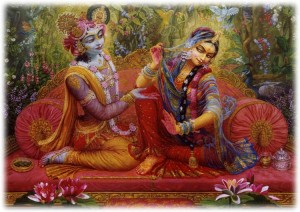
Sri Sri Radha And Krishna. Artist Srimati Syamarani
Access to Radha-Krsna-Lila
Srila Prabhupada has broadcast the pastimes of Sri Sri Radha and Krsna in Sri Caitanya- caritamrta, Krsna Book, Nectar of Devotion and Nectar of Instruction, and so on. If he were a cowherd boy, even the most intimate cowherd boy known as the priya-narma sakha, he would not have had full access to the understanding of Radha-Krsna lila, nor would he have been able to give his followers a clear understanding. Srila Krsnadasa Kaviraja Gosvami confirms this:
radha-krsnera lila ei ati gudhathara
dasya-vatsalyadi-bhave na haya gocara
sabe eka sakhi-ganera ihan adhikara
sakhi haite haya ei lilara vistara
sakhi vina ei lila pusta nahi haya
sakhi lila vistariya, sakhi asvadaya
“The pastimes of Radha and Krsna are very confidential. They cannot be understood through the mellows of servitude (dasya rasa), fraternity (sakhya rasa) or paternal affection (vatsalya rasa). Actually, only the gopis have the right to appreciate these transcendental pastimes, and only from them can these pastimes be expanded. Without the gopis, these pastimes between Radha and Krsna cannot be nourished. Only by their cooperation are such pastimes broadcast. It is their business to taste the mellows.” (Caitanya-caritamrta Madhya-lil, 8.201-3)
Following in the Footsteps of the Assistant Maidservants
Srila Prabhupada offered to take his followers back to Godhead, to serve the divine lila of Radha and Krsna. He therefore gave songs to help them attain that service. In 1970 he gave them the Tulasi arati song, beginning “namo namo tulasi krsna preyasi.” In this song devotees pray: “My desire is that you will also grant me a residence within the pleasure groves of Vrndavana. Thus within my vision I will always behold the beautiful pastimes of Sri Sri Radha and Krsna. I beg you to make me a follower of the cowherd damsels of Vraja. Please give me the privilege of devotional service and make me your own maidservant.”
In 1966, Srila Prabhupada gave his disciples the Sri Gurvastakam prayers by Srila Visvanatha Cakravarti Thakura, and they have been singing these prayers to him since that time. Verse six, beginning “nikunja yuno rati keli siddhyai”, describes the spiritual master as “very dear, because he is expert at assisting the gopis in making tasteful arrangements for the perfection of Sri Sri Radha Krsna's conjugal loving affairs within the groves (kunjas) of Vrndavan.” Every morning before his Srimad-Bhagavatam class he used to sing, “jaya radha-madhava kunjabihari, jaya gopi jana vallabha giri-varadhari: Krsna is the lover of Radha. He displays many amorous pastimes in the groves of Vrndavana. He is the lover of the gopis, the lifter of Govardhana.” A cowherd boy does not sing this song. In the Caitanya-caritamrta it is said that only by following in the footsteps of the gopis can one serve in the kunjas of Vraja (radha-krsna-kunjaseva). Both Sri Caitanya Mahaprabhu and Sri Raya Ramananda have told this:
sakhi vina ei lilaya anyera nahi gati
sakhi-bhave ye tanre kare anugati
radha-krsna-kunjaseva-sadhya sei paya
sei sadhya paite ara nahika upaya
“Without the help of the gopis, one cannot enter into these pastimes. Only he who worships the Lord in the ecstasy of the gopis, following in their footsteps, can engage in the service of Sri Sri Radha-Krsna in the bushes (kunjas) of Vrndavana. Only then can one understand the conjugal love between Radha and Krsna. There is no other procedure for understanding.”
Purport
“The means for returning home, for going back to Godhead, is devotional service, but everyone has a different taste in the Lord’s service. One may be inclined to serve the Lord in servitude (dasya-rasa), fraternity (sakhya-rasa), or paternal love (vatsalya-rasa), but none of these can enable one to enter into the service of the Lord in conjugal love. To attain such service, one has to follow in the footsteps of the gopis in the ecstasy of sakhi-bhava. Then only can one understand the transcendental mellow of conjugal love.” (Caitanya-caritamrta Madhya 8.204-5)
One may achieve the highest perfection of devotional service – residence at Sri Radha-kunda in Goloka Vrndavana – by taking shelter of the assistant gopis or manjaris:
“Living entities who are eager to return home to the transcendental kingdom of God, Goloka Vrndavana, by means of attaining their spiritual bodies (siddha-deha) should live at Radha-kunda, take shelter of the confidential serving maids of Sri Radha, and under their direction engage constantly in Her service…One should bathe there at Radha-Kunda regularly and give up all material conceptions, taking shelter of Sri Radha and Her assistant gopis. If one is thus constantly engaged during his lifetime, after giving up the body he will return back to Godhead to serve Sri Radha in the same way as he contemplated during his life on the banks of Radha-Kunda. The conclusion is that to live on the banks of the Radha-Kunda and to bathe there daily constitute the highest perfection of devotional service.”
(Nectar of Instruction verse 11 purport)
Krsna’s Dance Party
The process brought to the western world by Srila Prabhupada enables his followers to enter into and serve in Krsna's rasa-lila dance. Only the gopis join in this pastime. This and the following quotes reveal his ultimate purpose:
“This is spontaneous; this is life. And that is our real life in the spiritual world…The Vedanta says that God is anandamaya, full of bliss and pleasure. We are part and parcel of God; we are also of the same quality. Anandamayo ’bhyasat. So our whole process is to join the supreme anandamaya, Krsna, in His dance party. That will make us actually happy.” (Sria Prabhupada’s lecture in Los Angeles, Feb 13, 1969
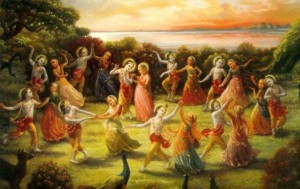
The Rasa Dance
The Iskcon Vaisnava acaryas’ songbook includes Srila Prabhupada’s recorded purport to Nitai-pada-kamalam’:
“Unless you take shelter under the shade of the lotus feet of Nityananda…“radha-krsna paite nai”…it will be very difficult to approach Radha-Krsna. This Krsna consciousness movement is for approaching Radha-Krsna, to be associated with the Supreme Lord in His sublime pleasure dance. That is the aim of Krsna consciousness. So Narottama dasa Thakura’s advice is, “If you actually want to enter into the dancing party of Radha-Krsna, then you must take shelter of the lotus feet of Nityananda.”
Srila Prabhupada would not promise his followers that he could give them a relationship with Krsna which he himself does not have and is thus not able to give. “Unless one practises devotional service himself, he cannot teach it to others. This conclusion is indeed confirmed throughout the Gita and Bhagavatam.” (Caitanya-caritamrta Adi 3.21)
Rupanuga-Bhakti and Manjari Bhava
Srila Prabhupada is strictly a follower in the line of Srila Rupa Gosvami. In the beginning of his preface to the Nectar of Instruction, he writes:
“The Krsna consciousness movement is conducted under the supervision of Srila Rupa Gosvami. The Gaudiya Vaisnavas, or Bengali Vaisnavas, are mostly followers of Sri Caitanya Mahaprabhu, of whom the six Gosvamis of Vrndavana are direct disciples. Therefore Srila Narottama dasa Thakura has sung “rupa-raghunatha-pade haibe akuti kabe hama bujhaba se yugala-piriti”…“When I am eager to understand the literature given by the Gosvamis, then I shall be able to understand the transcendental loving affairs of Radha and Krsna.” Sri Caitanya Mahaprabhu appeared in order to bestow upon human society the benediction of the science of Krsna. The most exalted of all the activities of Lord Krsna are His pastimes of conjugal love with the gopis. Sri Caitanya Mahaprabhu appeared in the mood of Srimati Radharani, the best of the gopis. Therefore, to understand the mission of Lord Sri Caitanya Mahaprabhu and follow in His footsteps, one must very seriously follow in the footsteps of the six Gosvamis—Sri Rupa, Sanatana, Bhatta Raghunatha, Sri Jiva, Gopala Bhatta and Dasa Raghunatha.
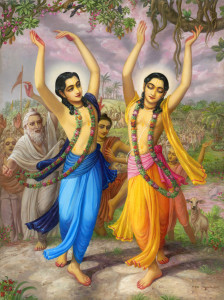
Lord Caitanya (right) and Lord Nityananda
“O My Friend” states that Gauridasa Pandita (an associate of Lord Nityananda) was in sakya-rasa, so Prabhupada must be too. It claims that although Gauridasa Pandita and his disciple Hrdaya Caitanya were in sakhya-rasa, Hrdaya Caitanya’s disciple Syamananda Prabhu tasted conjugal love. The inference there is that a devotee in sakya-rasa can give madhurya-rasa to his disciple. However, it fails to mention that in accordance with our Bhagavat-parampara, Syamananda Prabhu took siksa from Srila Jiva Gosvami, who was also in madhurya-rasa.
Moreover, Gauridasa Pandita was not in the line of Srila Rupa Gosvami. He was certainly an eternal associate of the Lord, but he was not Rupanuga. In the Guru-parampara kirtana that we sing daily, he is not mentioned as one of the acaryas in the Rupanuga line.
In his preface to Nectar of Devotion, Srila Prabhupada writes: “The present Krsna consciousness movement is also based on the authority of Srila Rupa Gosvami Prabhupada. We are therefore generally known as Rupanugas, or followers in the footsteps of Srila Rupa Gosvami Prabhupada.” This is also presented in the pranama mantras to Srila Bhaktisiddhanta Sarasvati Prabhupada: “madhuryojjvala-premadhya-sri-rupanuga bhaktida, sri-gaura-karuna-sakti-vigrahaya namo ’stu te. Again and again I offer obeisances unto Srila Sarasvati Thakura who is the mercy incarnate of Sri Gauranga Mahaprabhu, and who, as a follower of Sri Rupa Manjari, is bestowing ujjvala-madhurya-rasa, brilliant conjugal prema”.
This unnatojvalla rasa, or madhuryojjvala-rasa, is the same gift that Sri Caitanya Mahaprabhu came to bestow. This is the gift of all acaryas who are strictly in the line of Srila Rupa Gosvami. This gift of Mahaprabhu was not given by any previous acarya or incarnation. Mahaprabhu is Krsna Himself, and He came to this world for two reasons: to taste the glory of Srimati Radharani’s love and to engage the jivas in Her divine service, (see Adi 4.15-16). The following verse, appearing in Caitanya-caritamrta (Adi 1.4) was taken from Vidagdha-madhava, composed by Srila Rupa Gosvami.
anarpita-carim cirat karunayavatirnah kalau
samarpayitum unnatojjvala-rasah sva-bhakti-sriyam
harih purata-sundara-dyuti-kadamba-sandipitah
sada hrdaya-kandare sphuratu vah saci-nandanah
“May that Lord who is known as the son of Srimati Sacidevi be transcendentally situated in the innermost chambers of your heart. Resplendent with the radiance of molten gold, He has appeared in the Age of Kali, by His causeless mercy, to bestow what no incarnation ever offered before: the most sublime and radiant spiritual knowledge of the mellow taste of His service.” (Caitanya-caritamrta Adi 1.4)
The last part of this verse may also be translated as, “what no incarnation ever offered before – manjari-bhava, the service of Srimati Radhika as Her confidential maidservant.” Sri Caitanya-caritamrta states: “By nature, Srimati Radharani is just like a creeper of love of Godhead, and the gopis are the twigs, flowers and leaves of that creeper” (Madhya 8.210). Using the same analogy in his Sri Caitanya-caritamrta commentary, Srila Visvanatha Cakravarti Thakura has given the meaning of the phrase “sva-bhakti-sriyam.” This understanding is also explained below by Srila Bhaktivedanta Narayana Gosvami Maharaja:
“Then what has He come to give? Unnatojjvala-rasam sva-bhakti-sriyam. In this connection there is more emphasis on the final words, sva-bhakti-sriyam. ‘Sva’ means own. Own bhakti. Whose own? Srimati Radhika’s own. Krsna’s bhakti means Radhika’s bhakti, because Radhika is Herself the personification of Krsna’s bhakti. Sri Krsna wanted to taste the essence of supreme devotion to Himself, which is Radhika’s love, and He wanted to distribute to the qualified jiva His bhakti sriyam. ‘Sva’ means Radhika. ‘Bhakti’ means Radhika’s bhakti, and Sri means ‘shoba’, beauty. Sri Caitanya Mahaprabhu wanted to give the beauty of Srimati Radhika’s unnatojjvala-rasa.
“The following example will help us to understand. Imagine a creeper. If that creeper has no leaves, no fruits and no flowers, then it has no beauty. There are so many very green leaves, and so many flowers here and there on each branch. There are also manjaris, and some very sweet and delicious reddish or golden mangos. Cuckoos always eat these mangos and sing very sweetly. If the air touches and plays with these creepers, all the leaves become happy and begin to dance. At this time the manjaris also dance in happiness. This is the beauty of that creeper. However, if the creeper has no leaves, no manjaris, and no fruits, the air will not play with that branch. It will have no taste to play. If we see a creeper playing with the air, its leaves going here and there, and always dancing, that is the beauty of that creeper. Similarly, Sri Caitanya Mahaprabhu wanted to give the beauty of Srimati Radhika’s unnatojjvala-rasa. The creeper represents Srimati Radhika Herself. And what is the beauty? Her sakhis.
“Sri Caitanya Mahaprabhu has come only for unnatojjvala-rasa. What is this unnatojjvala-rasa? It is the gopis’ mood of service to Krsna, and particularly it is the mood of Srimati Radhika. Do not think that the use of the word gopi is sahajiyism. If this were the case, then Srila Krsnadasa Kaviraja (the author of Caitanya-caritamrta), Srila Rupa Gosvami (the author of this sloka), and Sri Caitanya Mahaprabhu (the emodiment of Caitanya-caritamrta) would all be sahajiyas; because this verse is the mangalacarana (invocation) and main verse of Caitanya-caritamrta. Unnatojjvala-rasa is of two kinds: the mood of Srimati Radhika and the gopis like Lalita, Visakha, Citra, etc., and also the mood of the palya-dasis, the maidservants of Srimati Radhika. The palya-dasis of Srimati Radhika do not want to serve Krsna if He is without Radhika. If Krsna, alone, is calling them, they will not go to Him; and they do not want to personally taste Him in any way. Sri Caitanya Mahaprabhu has come to distribute the mood of these maidservants, like Rupa manjari and Lavanga manjari, in their service to Srimati Radhika and Krsna. Srimati Radhika’s mood cannot be given; it is Hers exclusively. As Sri Caitanya Mahaprabhu, Krsna fully tasted her three moods. (Caitanya-caritamrta Adi 1.6)
“The pleasure that Srimati Radhika experiences in serving and seeing Krsna cannot be given to anyone, but the mood of the maidservant gopis can be given. Sri Caitanya Mahaprabhu has therefore come only to give this mood of service to Srimati Radhika, the mood of leaning more towards Her service than towards Krsna’s, but ultimately serving both. Prior to Sri Caitanya Mahaprabhu’s appearance, Sri Ramanujacarya, Sri Madhvacarya and so many Vaisnava acaryas had already appeared. Incarnations like Lord Rama and Lord Nrsimha had also descended. All of Them gave a very special contribution to the world, but none of them gave this prema, called bhakti-rasa, which Sri Caitanya Mahaprabhu gave through Srila Rupa Gosvami.
“There were so many great devotees present as intimate associates of Sri Caitanya Mahaprabhu – like the six Gosvamis, Sri Svarupa Damodara and Sri Raya Ramananda, but this sloka (sri-caitanya-mano-’bhistam…), composed by Srila Narottama dasa Thakura, was especially written to glorify Srila Rupa Gosvami. Because he is Rupa-manjari, he can understand the Lord’s innermost desires, and give to the jivas his own intimate service to Krsna. Srila Svarupa Damodara and Srila Raya Ramananda were Lalita and Visakha, and neither of their moods nor their specific type of service can be given. They serve Krsna like Srimati Radhika serves Him, in the sense that Krsna enjoys rasa with them and they taste Him directly.
“Srila Svarupa Damodara and Srila Raya Ramananda were the siksa–gurus of Srila Rupa Gosvami. Sri Caitanya Mahaprabhu requested them, as well as Nityananda Prabhu and all His other associates, to give special mercy to Srila Rupa Gosvami, so that he could realize His heart’s inner desire, and distribute it to the entire world. They all gave their mercy, and Srila Rupa Gosvami was thus empowered to compose literatures expressing Sri Caitanya Mahaprabhu’s inner moods. In this way, Srila Rupa Gosvami pleased the Lord. No one before Him had composed books like his.”
“Srila Bhaktivedanta Svami Maharaja has come to give these elevated principles through the Holy Name. For less qualified persons he also gave vaidhi-bhakti through the Name, but his innermost mood was to give this Krsna-prema…He was a Rupanuga Vaisnava, a follower of Rupa Gosvami, Rupa Manjari.”
(Pinnacle of Devotion)
The Rupanuga Vaisnava Disciplic Succession
Practically all of the bhajana songs that Srila Prabhupada personally sang are those of acaryas who have the siddha-deha of maidservants of Srimati Radharani. An example is “Radha-krsna prana mora jugala-kisora”, which describes the confidential service of the manjaris to the Divine Couple: “I will decorate black Krsna and golden Radharani with sandalpaste scented with cuwa. I will fan them with a camara and behold Their moonlike faces…” While singing the sad-gosvamy-astakam, Srila Prabhupada had such deep feelings that he would sometimes weep. As a follower of the Six Gosvamis, both externally and internally, he was engaged in his preaching mission and at the same time he was internally absorbed as a gopi-maidservant. The verse beginning ‘tyaktva turnam asesa mandala patim’ reflects this truth:
“I offer my respectful obeisances unto the six Gosvamis, namely Sri Rupa Gosvami, Sri Sanatana Gosvami, Sri Raghunatha Bhatta Gosvami, Sri Raghunatha dasa Gosvami, Sri Jiva Gosvami, and Sri Gopala Bhatta Gosvami, who kicked off all association of aristocracy as insignificant. In order to deliver the poor conditioned souls, they accepted loincloths, treating themselves as mendicants, but they were always merged in the ecstatic ocean of the gopis’ love for Krsna, and they bathed always and repeatedly in the waves of that ocean.”
Just before our revered Srila Prabhupada departed from the vision of this world in November 1977, Srila Bhaktivedanta Narayana Maharaja visited him, accompanied by Pujapada Sesasayi brahmacari. At that time, Srila Prabhupada listened to Sesasayi as he sang Sri Rupa manjari-pada. In this song, Srila Narottama dasa Thakura glorifies the lotus feet of Sri Rupa Manjari as his dearmost treasure, his topmost object of worship, the object of his devotional practices, his wealth, the beautiful ornament of his life, and the very life of his life.
Our whole guru-parampara, from Srila Madhavendra Puripada up to now; Sri Svarupa Damodara, Sri Raya Ramananda, and Srila Rupa Gosvami and all his followers – all are sakhis or manjaris. Sri Svarupa Damodara Gosvami and Sri Raya Ramananda are Lalita and Visakha respectively. The others, like Sri Rupa Gosvami, Sri Ragunatha das Gosvami and so on, are manjaris. If Srila Prabhupada were a cowherd boy, he would not at all be in the line of Srila Rupa Gosvami. Those who perform sadhana to become sakhas are not in the line of Rupa Gosvami. They are Raganuga Vaisnavas, but not Rupanuga. Raganuga-bhakti refers to all the mellow relationships with Krsna, like friendship, parental love, and conjugal love. (See C.c. 8, 153-157). Svarupa Damodara and Ramanada Raya are also not Rupanuga bhaktas. They are also not in the line following Rupa Gosvami. They are the gurus of Srila Rupa Gosvami. In our line – from Rupa Gosvami— our entire parampara consists of Rupanuga Vaisnavas. Prabhupada cannot be a sakha.
Sri Gaura Ganoddesa Dipika by Srila Kavi-karnapura, much of which is quoted in Prabhupada’s purports of Adi lila, ch 9-10, gives so much information about who Lord Caitanya’s associates are in Krsna-lila. For example, Srila Rupa Gosvami is Sri Rupa Manjari. Srila Raghunatha dasa Gosvami is Rati Manjari, Srila Jiva Gosvami is Vilasa Manjari, Srila Raghunatha Bhatta Gosvami is Rasa Manjari, and Srila Sanatana Gosvami is Lavanga Manjari. In the Gosvami literature it is revealed that Narottama dasa Thakura is Anuvilasa Manjari. In his Navadvipa Bhava Taranga, Srila Bhaktivinoda Thakura recognizes himself as Kamala Manjari.
We do not know of a single instance where an acarya in our Rupanuga line has a different svarupa and service from that of his guru, in whose footsteps he follows. Sadhakas of sakhya-rasa do not follow in the footsteps of Rupa Gosvami or Rupa Manjari. They follow in the footsteps of Subala who, according to the Gaura-ganoddesa-dipika, is Gauridasa Pandita in Caitanya-lila. Gauridasa Pandita is a raganuga acarya in our Gaudiya Vaisnava sampradaya, but he is not in the line of Srila Rupa Gosvami.
Srila Bhakti Raksaka Sridhara Maharaja states this as well (8/10/81): “Our sampradaya is known as Rupanuga; explicitly we profess that we are in madhurya-rasa.”
Our Srila Prabhupada directs us to follow in the footsteps of the gopis:
“To acquire this strong feeling of separation is the teaching of Lord Caitanya and His direct disciplic succession of Gosvamis. When we are not in physical contact with Krsna, we can associate with Him like the gopis, through feelings of separation. Krsna's transcendental form, qualities, pastimes and entourage are all identical with Him.
“There are nine different kinds of devotional service. Devotional service to Krsna in feelings of separation elevates the devotee to the highest perfectional level, to the level of the gopis. It is stated in Srinivasa Acarya's prayer to the six Gosvamis that they left the material opulences of government service and the princely status of life and went to Vrndavana, where they lived just like ordinary mendicants, begging from door to door. But they were so much enriched with the gopis' feelings of separation that they enjoyed transcendental pleasure at every moment.
“Similarly, when Lord Caitanya was at Jagannatha Puri, He was in the role of Radharani, feeling separation from Krsna. Those who are in the disciplic succession of the Madhva-Gaudiya-sampradaya should always feel separation from Krsna, worship His transcendental form and discuss His transcendental teachings, His pastimes, His qualities and His entourage. That will enrich the devotees to the highest devotional perfection. Feeling constant separation while engaged in the service of the Lord is the perfection of Krsna consciousness.” (Krsna Book Ch. 35)
Our Srila Prabhupada received diksa initiation from his Prabhupada, Srila Bhaktisiddhanta Sarasvati Thakura. Among the diksa mantras is the gopala mantra, which contains the words ‘gopi-jana-vallabhaya-svaha.’ This means, “I have accepted the same relation with Krsna that is accepted by all the gopis, ie: “Krsna is my beloved.” Srila Visvanatha Cakravarti Thakura has explained that this mantra is a gopi mantra, a mantra for developing the mood of the gopis. It is for ‘gopi bhava asraya’, taking shelter of their transcendental loving sentiments. The kama-gayatri is also only for becoming a gopi. It is not for any other mood.
In 1966, Srila Prabhupada introduced his Guru Maharaja’s pranama mantras, and Iskcon devotees have been chanting them since that time. These mantras describe Srila Bhaktisiddhanta Sarasvati Thakura’s merciful distribution of rupanuga-bhakti and his intolerance of those misconceptions which are opposed to the precepts enunciated by Srila Rupa Gosvami. Srila Sarasvati Thakura also revealed his svarupa as Nayana Manjari to several of his most intimate disciples. In Gaudiya Patrika he also revealed the identity of Srila Gaura-kisora das Babaji as Guna Manjari. In a letter to Hamsaduta (Jan 16, 1969), Srila Prabhupada answered a question regarding the svarupa of his Guru Maharaja: “My Guru Maharaja’s position was one of the assistants of the manjaris”.
In 1959 Srila Prabhupada took sannyasa from his revered god-brother Srila Bhakti Prajnana Kesava Gosvami Maharaja, who is Vinoda Manjari in Krsna-lila. The sannyasa-mantra Srila Prabhupada received is the mantra of all sannyasis in the line of Srila Rupa Gosvami. It is a gopi-mantra, a prayer for becoming a gopi.
The Role of the Priya-Narma Sakhas
The confidential role of the priya-narma sakhas is described in the Nectar of Devotion as follows:
“There are other friends who are still more confidential. They are called priya-narma, or intimate friends. Counted among the priya-narma friends are Subala, Arjuna, Gandharva, Vasanta and Ujjvala.
There was talk among the friends of Radharani, the gopis, about these most intimate friends. One gopi addressed Radharani thus: “My dear Krsangi [delicate one], just see how Subala is whispering Your message into Krsna’s ear, how he is delivering the confidential letter of Syama-dasi silently into Krsna’s hand, how he is delivering the betel nuts prepared by Palika into Krsna’s mouth, and how he is decorating Krsna with the garland prepared by Taraka. Did you know, O My Friend, that all these most intimate friends of Krsna are always engaged in His service in this way?” (Ch. 41)
This quote is additional evidence that Prabhupada is not a priya-narma sakha. As a rupanuga devotee, Srila Prabhupada, in his siddha-sarira as a maidservant of Radhika, would only serve Krsna in relation to Radhika, not in relation to other groups of gopis. In Bhakti-rasamrta- sindhu-bindu, Srila Visvanatha Cakravarti Thakura writes that Syama dasi is a suhrt–paksa gopi. This means she is on friendly terms with Srimati Radharani and Her group (headed by Lalita and Visakha and Rupa Manjari), but she is not actually in that intimate group herself. Palika is tatastha-paksa. This means she is neutral towards Srimati Radhika’s group and friendly towards Candravali’s group. (Candravali is Srimati Radharani’s rival.) Taraka is vipaksa. This means she is opposed to Radhika, as is Srimati Candravali. The following is the actual verse by Srila Visvanatha Cakravarti Thakura:
akhila-rasamrta-murtih prasrmara
rucir-uddha-taraka-palih
kalita-syama-lalito
radha-preyan vidhur jayati
“Let there be all glory to omnipotent Lord Sri Krsna Candra who is endowed with all excellence and who is the personificationof transcendental bliss charaterised by the twelve forms of rasa – five primary (mukhya-rasa: santa, dasya, sakhya, vatsalya, and madhura) and seven secondary (gauna-rasa: laughter, wonder, compassion, anger, fear, heroism, and disgust). By the radiance of His limbs which is spreading in all directions, He has brought under His control the yuthesvaris or leaders of the various groups of gopis, named Taraka (vipaksa – representing a rival group to that of Sri Radha) and Pali (tatastha paksa – representing a neutral group). He has made Syamala (suhrta paksa – representing a friendly group) and Lalita (svapaksa – belonging to Radhika’s own group) His very own, and He is the most beloved of Srimati Radhika That is, being under the control of the prema of Srimati Radhika, who is the embodiment of the mahabhava of all the yuthesvaris, He is always intently absorbed in inspiring Her love.”
A maidservant (manjari) of Srimati Radhika, being svapaksa, within Her very intimate group, would never give Krsna a garland made by Taraka, who is opposed to Her, as Subala is described as doing in the above-mentioned verse of Nectar of Devotion.
A devotee once gave a leaf-cup filled with buttermilk to Srila Raghunatha dasa Gosvami. In his siddha-sarira, Ragunatha dasa Gosvami is Rati Manjari, one of the leaders of Srimati Radhika’s maidservants. When he heard that the leaf-cup had come from sakhi-sthali, the abode of Candravali, he immediately threw it away. Being completely loyal to his Svamini, Srimati Radhika, he even wanted to beat that devotee with a stick.
Srila Bhaktivinoda Thakura who, in his siddha-sarira (gopi form) serves Srimati Radhika as Kamala Manjari, writes in his book Saranagati, in the fourth song of Bhakti-Pratikula-Bhava Varjanangikara (Renunciation of Conduct Unfavorable to Pure Devotion):
ami to’ swananda-sukhada-basi
radhika-madhava-carana-dasi
dunhara milane ananda kori
dunhara viyoge duhkete mari
sakhi-sthali nahi heri nayane
dekhile saibyake paraye mane
je-je pratikula candrara sakhi
prane duhkha pai tahare dekhi’
radhika-kunja andhara kori’
loite cahe se radhara hari
sri-radha-govinda-milana-sukha
pratikula-jana na heri mukha
radha-pratikula jateka jana-
sambhasane kabhu na hoy mana
bhakativinoda sri-radha-carane
sanpeche parana ativa jatane
1) Oh, I am resident of Svananda-sukhada-kunja, and a maidservant of the lotus feet of Radhika and Madhava.
2) I happily rejoice at the union of the Divine Couple, and in Their separation I die in utter anguish.
3) I never look at the area in Vraja called Sakhi-stahli where Candravali and her friends live. If I were to see that place, it would remind me of Candravali’s sharp-tongued gopi named Saibya.
4) I feel pain in my heart whenever I happen to catch sight of Candravali’s proud girlfriends, for they are all inimical to Radha’s camp.
5) Candravali wants to take away Radha’s Lord Hari, thus causing the love-grove of Radhika to be overcast with the darkness of gloom.
6) I never look at the faces of those who wish to obstruct the joy of the union of Sri Radha and Govinda.
7) Nor do I find any pleasure in conversing with those who are members of a camp opposed to Radha.
8) Bhaktivinoda has entrusted his soul with great care unto the lotus feet of Srimati Radharani.
Although there is a certain intermingling of madhurya-rasa in the service of the priya-narma sakhas, they follow in the footsteps of associates like Subala, not the gopis. The priya-narma sakhas serve in the lila of Radha-Krsna in their own way, and the seva which they perform is clearly distinct from that of the manjaris.
The manjaris’ seva, also described in the song “Radha-Krsna prana mora” by Srila Narottama dasa Thakura, is the service upon which all the acaryas in our line have meditated and instructed their disciples. This service is specific to the manjaris, who have special access to the lilas of Radha-Krsna. The priya-narma sakhas can touch mahabhava, but not more than that. In Jaiva-dharma and Bhakti-rasamrta-sindhu it is written that they can take shelter of some small aspect of sakhi-bhava. They cannot be like Rupa Manjari, who can even taste Srimati Radhika’s madanakya maha-bhava (the highest development of mahabhava, which is not even found in Lalita and Visaka of Sri Krsna). They cannot serve Krsna and Radha while they are playing in the kunjas. They can never go there. Subala may sometimes bring Krsna to a kunja, but he can never go inside and serve. The gopis, on the other hand, can enter the kunja, and they can also dress and decorate Radha and Krsna there. In his Vraja Vilasa Stava, Text 31, Srila Raghunatha dasa Gosvami writes:
tambularpana-pana-mardana-payo-danabhisaradibhir
vrndaranya-mahesvarim priyataya yas tosayanti priyah
prana-prestha-sakhi-kulad api kilasankocita bhumikah
keli-bhumisu rupa-manjari-mukhas ta dasika samsraye
“I take shelter of Sri Rupa Manjari and the other very dear maidservants of the great queen of Vrndavana, Srimati Radhika, who please Her by offering Her betel, massaging Her feet, offering Her water, and arranging for Her rendezvous with Krsna. Because these maidservants can enter the area where the Divine Couple enjoy Their most confidential pastimes without feeling shy, they are even more dear to Radhika than sakhis such as Lalita, who themselves are more dear to Her than life itself. In other words, the manjaris, headed by Sri Rupa Manjari, can freely enter those kunjas where even the prana-prestha sakhis hesitate to enter.”
Srila Bhaktivinoda Thakura’s Jaiva-dharma describes a conversation between Srila Gopal-guru Gosvami and his disciple Sri Vijaya Kumara. Gopal-guru Gosvami told his disciple that he should come and speak with him privately, not with Brajanatha, because Brajanatha was a follower of Subal, and therefore had no adhikara (qualification) to listen to his madhurya-katha.
Srila Prabhupada wrote a poem on his arrival to America in 1966 wherein he states his desire to frolic in Vrndavana, and therefore some persons think that he is a sakha: “O dear friend, in Your company I will experience great joy once again. In the early morning I will wander about the cowherd pastures and fields. Running and frolicking in the many forests of Vraja, I will roll on the ground in spiritual ecstasy. Oh, when will that day be mine?”
Actually, this is also part of the speciality of Srila Prabhupada’s unnatojjvala-rasa, his constitutional position as a gopi. Srimati Radhika can also do this. Sometimes She serves Krsna like a mother, because the mood of mother is also there in Her, as stated in Sri Caitanya-caritamrta, Madhya-lila, 8.83-87. Sometimes Radhika also serves like a sakha, and in many of our Gosvamis literatures there are descriptions of this. Sometimes She wrestles with Krsna, jokes, plays dice and other games, and engages in water-sports with Him. Subala has to struggle to defeat Krsna in a wrestling match, but Srimati Radhika simply attires Herself in her wrestling garb, gives Krsna a sidelong glance and He becomes unconscious. In consequence, the divine existence of Prabhupada’s poem is not an indication of a position as a cowherd boy.
Devotees who are eternally established in sakhya-rasa as priya-narma sakhas, as well as those sadhakas performing sadhana-bhajana to become priya-narma sakhas, do not follow in the footsteps of the gopis. They follow in the footsteps of Subala. This is explained in the Nectar of Devotion: “Devotees who are attracted to Krsna as parents or as friends should follow in the footsteps of Nanda Maharaja or Subala, respectively. Nanda Maharaja is the foster father of Krsna, and out of all the friends of Krsna, Subala is the most intimate in Vrajabhumi.”
Empowerment by Sri Nityananda
“O My Friend” states that Srila Prabhupada’s establishment of the worship of Radha-Krsna, Gaura-Nitai, and Krsna-Balarama demonstrates that he was influenced by the mood of a priya-narma sakha, because he was empowered by Nityananda Prabhu. This idea may have come from the following information in a purport to Sri Caitanya-caritamrta:
“One should always think of the spiritual master in terms of his intimate relationship with Mukunda (Sri Krsna)…following in the footsteps of Srila Raghunatha dasa Gosvami and Srila Jiva Gosvami…In all the ancient scriptures of devotional service and in the more recent songs of Srila Narottama dasa Thakura, Srila Bhaktivinoda Thakura and other unalloyed Vaisnavas, the spiritual master is always considered either one of the confidential associates of Srimati Radharani or a manifested representation of Srila Nityananda Prabhu.” (Caitanya-caritamrta Adi 1.46)
But these two viewpoints – one of the confidential associates of Srimati Radharani” and “a manifested representation of Srila Nityananda Prabhu” are not mutually exclusive. ‘Either one or the other’ is understood in terms of two different viewpoints, not two types of spiritual masters. Nityananda Prabhu, being non-different from Lord Balarama, the original spiritual master, is akhanda guru-tattva, the embodiment of the complete principle of guru-tattva. As such, all the gurus in the line of Rupa Gosvami are His direct manifestations and are empowered by Him. Yet, at the same time, they are also maidservants of Srimati Radharani. In many of their songs they pray for the mercy of Nityananda Prabhu (Nitai Pada Kamala; Parama Karuna; Gauranga Bolite Habe etc.).
Srila Bhaktisiddhanta Sarasvati Thakura states in his article called “Associates of Sri Caitanya”:
“But Nityananda does not directly instruct in the confidential service of Krsna. Srimati Radhika is the guru of the inner circle of the servants of Krsna. Srimati, however, accepts the offering of service only of those souls who are specially favored by Nityananda and are deemed by Him to be fit for Her service.”
At the end of every chapter of his book, Navadvipa Dhama Mahatmya, Srila Bhaktivinoda Thakura expresses his relationship with Lord Nityananda. At the end of chapter nine he writes: “Bhaktivinoda, within whom the ever-worshipable Jahnava and Nitai have appeared, sings the glory of Nadia and the sweetness of the devotees, while tasting transcendental flavors.” As quoted previously from Prabhupada’s commentary on ‘Nitai pada kamala,’ “If you actually want to enter into the dancing party of Radha-Krsna, then you must take shelter of the lotus feet of Nityananda.”
Nityananda Prabhu is thus indicated as the embodiment of the complete principle of guru-tattva, who enables us to approach Sri Sri Radha-Krsna, through the grace of Sri Caitanya Mahaprabhu. Therefore, according to the acaryas, “The spiritual master is always considered either one of the confidential associates of Srimati Radharani or a manifested representation of Srila Nityananda Prabhu.”
Considering all of this, it is clear that the word “or” in the Caitanya-caritamrta Adi 1.46 purport cannot be construed to simply mean ‘one or the other’. Certainly it means that the identity of the spiritual master is to be understood both in terms of the principle of guru-tattva, as well as in terms of the guru’s manjari-svarupa within the lila of Goloka Vrndavana.
There is another interesting point. Nityananda Prabhu has two forms in krsna-lila. One is Ananga Manjari and the other is Sri Baladeva Prabhu. Therefore, some of His associates in Goloka Vrndavana are associates of Ananga Manjari as manjaris, and others are associates of Baladeva. In his Gita Mala, Srila Bhaktivinoda Thakura speaks of himself as a follower of Ananga Manjari.
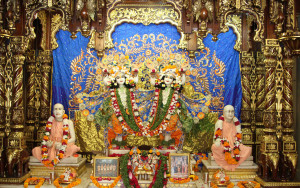
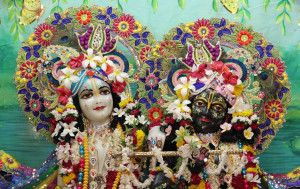
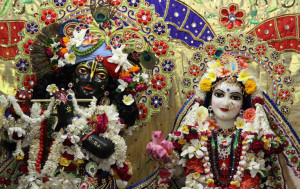
Installation of Krsna-Balarama and Gaura-Nitai Deities
“O My Friend” states that Srila Prabhupada established Krsna-Balarama Deities in Vrndavana because he was a sakha, but Srila Prabhupada himself explained it in a different way. The introduction of Sri Sri Gaura-Nitai was made especially for the benefit of the most fallen souls. In this way they might become eligible to worship Sri Sri Radha-Krsna. In a Caitanya-caritamrta purport, Prabhupada explains:
“Since there is no prominent Krsna-Balarama temple in Vrndavana, we are attempting to construct one so that people will be attracted to Krsna-Balarama, or Nitai-Gauracandra. “Vrajendra-nandana yei, saci suta haila sei”. Narottama dasa Thakura says that Balarama and the son of Maharaja Nanda have advented Themselves as Gaura-Nitai. To propagate this fundamental principle, we are establishing a Krsna-Balarama temple to broadcast to the world that worship of Gaura-Nitai is the same as worship of Krsna-Balarama.
“Although it is very difficult to enter into the Radha-Krsna pastimes, most of the devotees of Vrndavana are attracted to the Radha-Krsna lila. However, since Nitai-Gauracandra are direct incarnations of Balarama and Krsna, we can be directly in touch with Lord Balarama and Lord Krsna through Sri Caitanya Mahaprabhu and Nityananda Prabhu. Those who are highly elevated in Krsna consciousness can enter into the pastimes of Radha-Krsna through the mercy of Sri Caitanya Mahaprabhu.” (Caitanya-caritamrta Madhya 6.281)
Srila Gour Govinda Maharaja was specifically instructed by Srila Prabhupada to establish Krsna-Balarama Deities in Bhubaneswar, Orissa. Prabhupada gave him detailed instructions on how this should be carried out. Below is an excerpt from The Flow of Nectar, where Srila Gour Govinda Maharaja explains something of the significance of this worship.
“Balarama is white, and there is a reason for it. You see, Balarama is Nityananda prabhu, Nityananda Rama…“Nitai-pada-kamala, koti-candra-susitala”. His lotus feet are as cool as the cooling effect of crores of moons. So, what is the color of moonlight? That is white. So much mercy. Therefore Balarama has a plow in his hand, and Krsna a flute. That is Krsna-Balarama, plow and flute. So first cultivation; karsana is needed. Then all nasty weed-like things will be rooted out. The field should be cultivated properly with the plow of Balarama, then the field of the heart, hrdaya-ksetra, becomes fertile, and the seed of the devotional creeper, bhakti-lata, will be sown.
“That should not be a barren land. If you sow the seed in a barren land, the seed will never fructify. That is what Gopinathacarya said to Sarvabhauma Bhattacarya, “Why am I sowing seeds in a barren land? I am doing useless labor, because it will never fructify.” So, after proper cultivation by Balarama’s plow, when the land is fertile, the seed should be sown. Then, when you develop prema-bhakti you will be attracted by Krsna’s flute. The flute means akarsana, attraction. Karsana-akarsana, cultivation and enchantment. So, this is the Krsna-Balarama Mandira."
Srila Prabhupada explained his reasons for establishing Gaura-Nitai deities in Atlanta, Georgia. Below is an excerpt from his arrival address there:
“Caitanya Mahaprabhu is very kind. Parama karuna, pahu dui jana. Two Lords, Nitai-Gauracandra, Nityananda Prabhu and Sri Caitanya Mahaprabhu, They are very kind. You see? They have appeared just to reclaim the fallen souls of this age.” (Feb. 28 1975)
In Bhubaneswar, he explained the same point:
Srila Prabhupada: ‘No. When they have actually advanced and been initiated and are following strictly the Vaisnava principles, then Radha-Krsna. And Gaura-Nitai they can worship in any condition… At least if they see and chant Hare Krsna that will make them advance. Chanting of Hare Krsna maha-mantra before Gaura-Nitai will make them very quickly advanced in spiritual consciousness. Very quickly. There is no offense. He does not take any offenses. Whatever little service they do, it is accepted by Gaura-Nitai.” (Conversation Feb 2 1977)
The worship of Sri Sri Gaura-Nitai is especially suitable for those who are fallen and lack the qualification to perform devotional service. There is no consideration of offences in Their worship.
The honorable Srila Sridhara Maharaja states (January 4, 1982):
Mahaprabhu and our acarya-parampara, guru-parampara, we find that all the gurus there are of madhurya-rasa, not sakhya-rasa. Mahaprabhu Sri Caitanya, then Svarupa, Rupa, Sanatana, Kaviraja, Narottama, Visvanatha Cakravarti, all; Gaurakisora dasa Babaji Maharaja, our Prabhupada, Bhaktivinoda Thakura – all are acaryas of madhurya-rasa.
“And Prabhupada, our Guru Maharaja, also followed the same path: Radha-Govinda, and both of them combined is Mahaprabhu. When Radharani is [there with Krsna], Baladeva cannot stay there by the side of Krsna, because there will be a clash in the service, or rasa. Baladeva is the elder brother of Krsna, and when Krsna is with His elder brother, Radharani cannot approach Krsna there at that time; and when Radha-Krsna are there, then Baladeva can't come there. There is a clash in vatsalya- and sakhya- and madhurya-rasa.
“And Prabhupada closely followed this line – that Mahaprabhu can stay, [as He is] both Radha and Krsna combined, nothing else. So where Radha-Govinda are, then Mahaprabhu can stay in the same place. Both combined; but no other rasa, representation, to be there. Only the sakhis of Radharani, the loving friends of Radharani, they can stay there. They are also of the same tendency of madhurya-rasa service, so they may stay with Radha-Krsna.
“So when I heard that Svami Maharaja had installed Radha-Govinda and there some sakhis are also in their side, but Krsna-Baladeva [are situated] separately, and Gaura Nityananda are also [situated separately, in a separate prakostha], this is by the analysis of the rasa; the ontology of love, the psychology.
“We have to understand in their line. So, it is general recruitment in sakhya-rasa, and by the grace of Nityananda Prabhu and Baladeva, that was effected, and that achieved a great success by following that path. So, to show his real gratitude to Baladeva, Nityananda, he installed Them especially. Gaura Hari bol.”
In “The Golden Volcano” Srila Sridhara Maharaja describes Nityananda’s mercy as “very lavish and almost blind” because “He does not discriminate between different degrees of sinners. His mercy is all-embracing. And Sri Caitanya Mahaprabhu cannot dismiss His recommendation. Even those who Sri Caitanya Mahaprabhu rejected, Nityananda Prabhu sheltered and gradually Mahaprabhu had to accept them.” It was for this reason Srila Prabhupada recommended the worship of Gaura-Nitai throughout the world. There is no reason to take it as symptomatic of a predilection to sakhya-bhava. Moreover, he planted the seed for the worship of Gaura-Gadadhara:
Sangopangastra-parsadam. This is the description of God, Krsna, in this age. That is Caitanya Mahaprabhu. Krsna-varnah tvisakrsnah sangopangastra-parsadam. And how to worship Him? What is the process? Yajnaih sankirtanaih. That’s all. You keep Caitanya Mahaprabhu’s Deity and chant and dance – your life is successful. So easy. We are worshiping Radha-Krsna. That is very difficult. But if we keep Caitanya Mahaprabhu with His associates, this Panca-tattva, Gaura-Nitai, Gaura-Gadadhara, or Panca-tattva, and worship Him according to the sastric description… The sastric description is yajnaih sankirtanaih.”
(Srila Prabhupada’s lecture of March 10, 1972, in London)
“O Dear Friend”
“O My Friend” quotes Srila Prabhupada on the Jaladuta: “O dear friend, in Your company I will experience great joy once again. In the early morning I will wander about the cowherd pastures and fields. Running and frolicking in the many forests of Vraja, I will roll on the ground in spiritual ecstasy. Oh, when will that day be mine?”
It certainly appears that Srila Prabhupada is alluding to a sakhya-rasa relationship here, as there are so many things he kept somewhat hidden in the beginning of his mission in the West. Here, his madhurya-bhava is veiled to those who were not yet ready for such knowledge. A deeper look shows that, yes, surely he is Krsna's friend, in the sense that all the gopis are His friends. In Caitanya-caritamrta Adi-lila 4.211, Sri Krsna Himself declares, “O Partha, I speak to you the truth. The gopis are my helpers, teachers, disciples, servants, friends, and consorts. I do not know what they are not to Me.”
And the gopis also frolic in the cowherd pastures and fields. In Antya-lila Chapter 20, Mahaprabhu says in the mood of Radhika, “Abandoning the other beautiful gopis, He may manifest My good fortune by coming under My control. By sporting with Me in front of them, He will bring about their distress. On the other hand, being a wicked, impudent, and crafty debauchee, He may torment Me by frolicking with other gopis in My presence. Regardless of what He does, He is the Lord of My life.” In fact, if the Acaryabase Folio can be taken as having true references, we see there that Tripurari Maharaja writes in his commentary in Bhagavad-gita [Ch.10, text 8], “Sri Radha and the gopis drew the dhira-lalita nayaka of Vraja from Krsna’s heart, reminding Krsna of their youthful days of love in carefree Vraja: frolicking in its beautiful forests, Mount Govardhana, and the sandy banks of the Yamuna.”
Srila Prabhupada Has the Highest Relationship
Some think that all rasas or relationships with Krsna are equal, and therefore it does not matter whether Srila Prabhupada is in one rasa or another. But this is not the case:
“It is true that whatever relationship a particular devotee has with the Lord is the best for him; still, when we study all the different methods from a neutral position, we can understand that there are higher and lower degrees of love.
“Increasing love is experienced in various tastes, one above another. But that love which has the highest taste in the gradual succession of desires manifests itself in the form of conjugal love. There is a gradual order of improvement in transcendental mellows from the initial ones to the later ones. In each subsequent mellow the qualities of the previous mellows are manifest, counting from two, then three, and up to the point of five complete qualities.
“As the qualities increase, so the taste also increases in each and every mellow. Therefore the qualities found in santa-rasa, dasya-rasa, sakhya-rasa and vatsalya-rasa are all manifest in conjugal love [madhurya-rasa]. The qualities in the material elements—sky, air, fire, water and earth—increase one after another by a gradual process of one, two and three, and at the last stage, in the element earth, all five qualities are completely visible.” (Caitanya-caritamrta Madhya. 8.83-87)
It is this madhurya-rasa that Sri Caitanya Mahaprabhu especially came to give, through a development, beginning from vaidhi-bhakti performed in the association of pure devotees, leading to raganuga-bhakti, and then on to ragatmika-bhakti, the fully-blossomed love of the residents of Vrndavana. Srila Prabhupada established temples, schools and farms, and the beginnings of varnasrama. He also published many books in several languages, and he travelled several times around the world to give his personal association. Development of this type of ragatmika-bhakti in the conditioned souls was his ultimate goal throughout all these activities.
The conclusion then, is that Srila Prabhupada is one of the intimate palya-dasis, assistant maidservants, of Srimati Radharani, and the mercy-potency of Sri Caitanya Mahaprabhu. People and devotees understand this topic, and all topics, according to adhikara (qualification) and sanskaras (impressions on the heart due to activities in this and previous lives). We have no intention to minimize anyone. Our only intention is to defend the true glory of Srila Prabhupada and his guru-parampara.
The following links below lead to an essay in 3 parts by Mukunda Das, a Disciple of Srila Bhaktivedanta Narayana Goswami Maharaja
How to understand that Srila Prabhupada is in madhurya rasa, but manifested sakhya part 1
How to understand that Srila Prabhupada is in madhurya rasa but manifested sakhya part 2
How Srila Prabhupada has both rasas and why, part
Scriptural evidence and quotes send by various devotees collected by Sudevi dasi on FB







